
The BEST 16 Things to Do in Busan for an Exciting, Epic Trip
Everyone’s heard of the mega-popular K-pop group BTS, and it’s common knowledge that members Jimin and Jungkook are from Busan. Besides having two BTS members born there, Busan is the second largest city in South Korea, and it’s also known for its beaches, seafood, and the renowned Busan International Film Festival. There are so many fun things to do in Busan!
I love going to Busan because it’s a big city but has the feel of a small town. Compared to Seoul, Busan has a laidback feel and a more relaxed lifestyle, perhaps because of its proximity to water (yay beaches). I wish my three-day trip to Busan were longer; there was so much to do! If you’re traveling to Busan soon, here are the best things to do in Busan for an epic trip!
The 16 Best Things to Do in Busan, South Korea
From relaxing by the beach to having a peaceful afternoon at a temple, there are so many amazing things to do in Busan. But first, I want to start with an unconventional activity…
1. Admire the View Outside of Busan Station
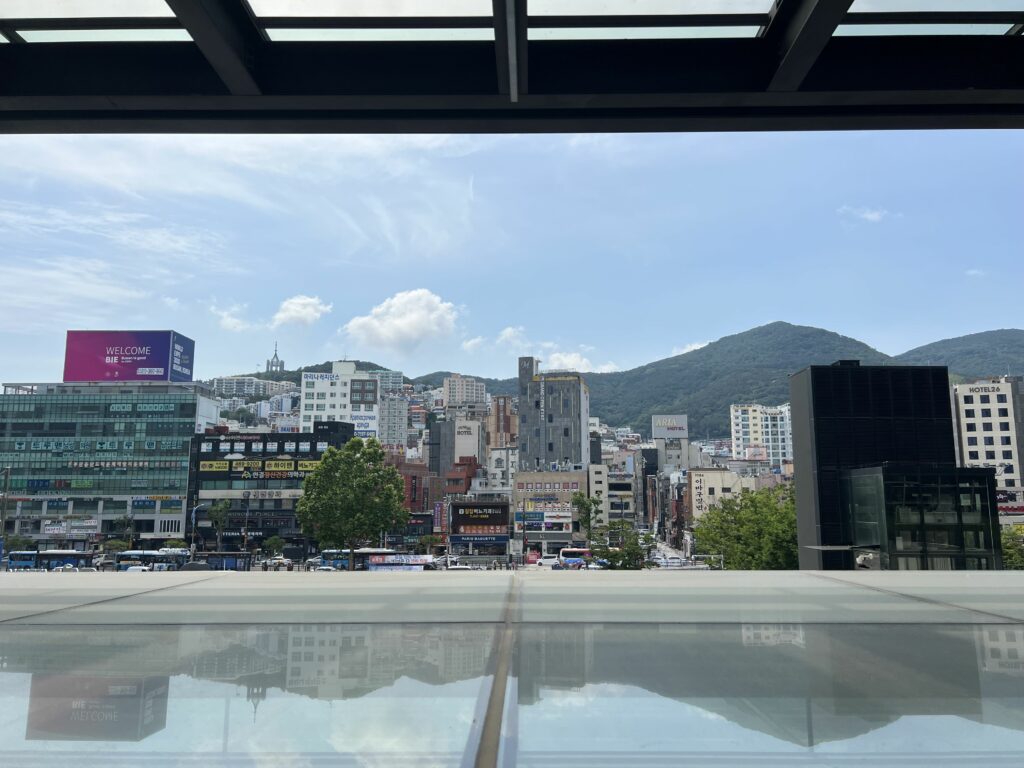

Before you embark on your adventure in Busan, one of the best things to do in Busan, Korea, is to admire the scenery from the Busan Train Station! Immediately after exiting the station, you’re confronted with an amazing view of Busan. The buildings are on a slope and layer behind one another, like singers standing on choir pews. Behind the buildings are mountains! The view is absolutely stunning and really captures the urban layout of Busan. Snap a picture while you can!
After exiting the station, I couldn’t believe that such an amazing view existed from such a random location. You feel awestruck and inspired, especially after sitting on a train for two and a half hours. If you’re coming from Seoul to Busan, there are various options to consider, but taking the train is the best option.
2. Try Busan Famous Foods
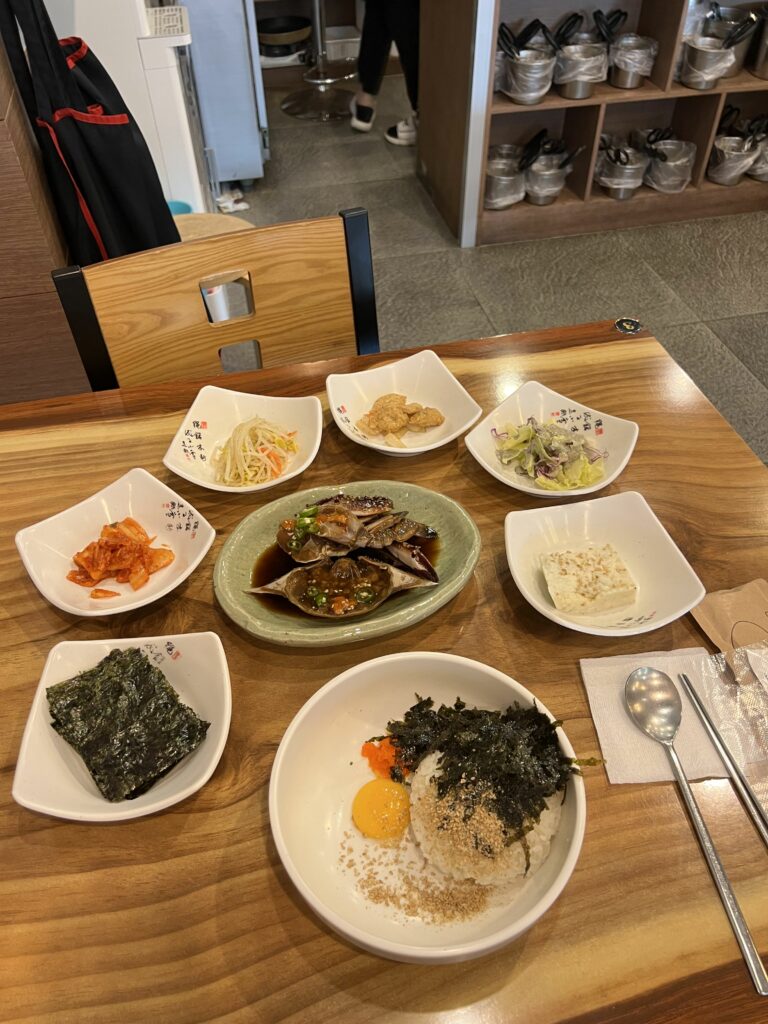

On a list of things to do in Busan, food has to be one of them. Busan is known for its seafood, but it also has certain twists on classic Korean dishes that are definitely tasty and memorable. Here’s a short list of some of the dishes Busan is known for:
- Ganjang Gejang 간장게장
- This is soy-sauce marinated raw crab, otherwise known as the rice killer. It’s a strongly seasoned raw crab that has been marinating in a soy sauce marinade overnight. It’s a slightly sweet, mostly salty dish that tastes amazing. It’s called the rice killer because it makes you want to eat a lot of rice, haha. Busan is known for its fresh seafood, which can only make marinated crab taste better!
- Milmyeon 밀면
- It’s a cold wheat noodle soup served with beef, a boiled egg, radish, and cucumbers. It originated after the Korean War when North Korean migrants settled in Busan and made their version of naengmyeon, which is cold buckwheat noodle soup. It’s eaten with vinegar and mustard, as well as a side of hot soup. It’s super refreshing on a hot day and incredibly flavorful. You have to try this dish at the famous Choryang Milmyeon, which is right across from the Busan Station.
- Hotteok 호떡
- This is a brown sugar-filled fried pancake that is ooey-gooey deliciousness. You can’t go wrong with a hotteok on a cold day! Or even a hot day. It’s the perfect sweet snack. Busan has its own version called Ssiat hotteok (씨앗호떡), which is hotteok with seeds inside. The seeds add a great roasted flavor to the already yummy pancake, and it’s a must-try!
- Dwaeji Gukbap 돼지국밥 Pork Bone Soup
- Jokbal 족발 Braised Pork Trotters
3. Visit Gwangalli Beach + Diamond Bridge

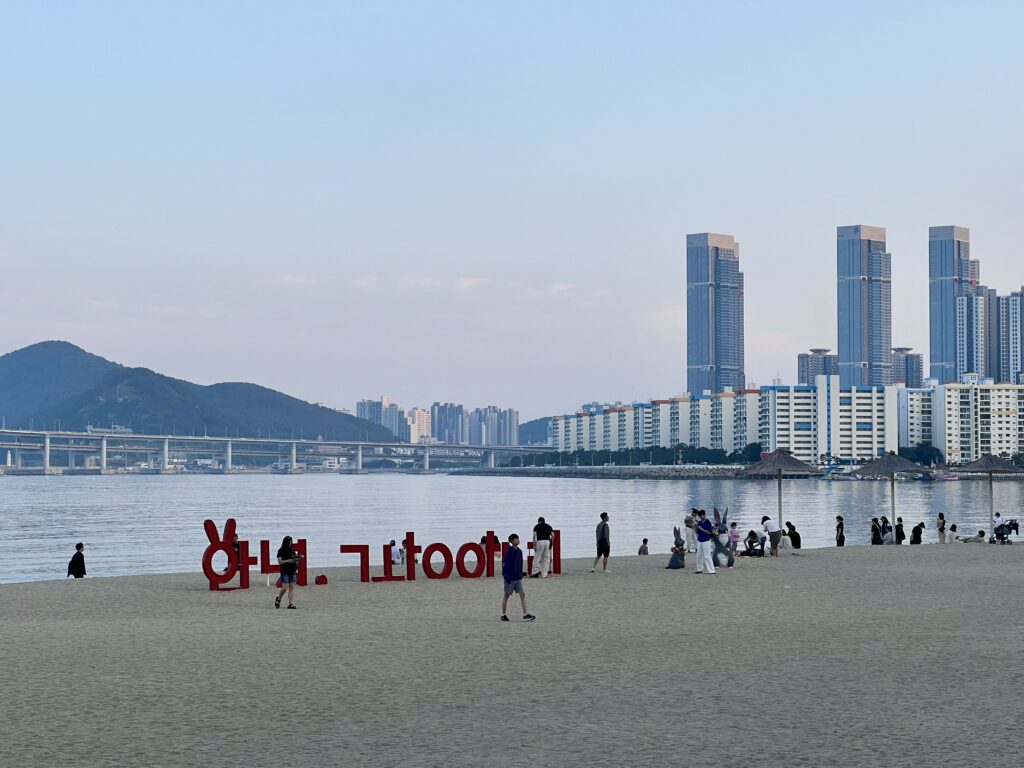
Gwangalli Beach is a long, white sand beach famous for its soft, powder sand. It’s also known for its view of the Gwangan Bridge or Diamond Bridge, which sits over the ocean. Along the beach are dozens of boutiques, clubs, bars, restaurants, and cafes. You can walk along the beach and window shop for your next souvenir, drink, or meal.
This beach is a must-visit at night, where you can enjoy the sparkling scenery, and is a popular spot for couples. Every night, you can see fireworks shooting from boats near the base of the Gwangandaegyo Bridge or Diamond Bridge. I’m not sure why the fireworks are shot off the boats, but it makes for a great show!
The best view of the bridge is at one of the cafes or restaurants lining the beach. My favorite is Cafe Mignon, and it has three levels with large, open windows that offer amazing views of the entire beach and bridge. Grab a coffee, snack, or meal and enjoy the sea breeze and postcard-perfect image.
There is also a light show that happens every night at 8 and 10 p.m. On Friday and Saturday, there is also an additional show at 9 p.m. From November to April, the Gwangan Bridge lights up at night, starting at sunset all the way until midnight, sometimes later. In October, the Busan International Fireworks Festival takes place in front of Gwangan Bridge.
4. Sift Through Books at Bosudong Book Street


This charming street, spilling over with books, is an important consequence of the Korean War, dating back more than 70 years. Following the liberation from Japanese colonization in 1945, locals in Bosu-dong started selling books left behind by the Japanese to make a living. Shortly after, vendors from all over the country moved to Bosudong, opening secondhand bookshops carrying every and any book. Each shop is cluttered and crammed with books from every topic and discipline. Book lovers will enjoy rummaging through collections of books and might even find a rare or vintage book!
A lot of bookstores also function as a cafe or have turned into a cafe due to the rise of chain bookstores across Korea, making smaller bookstores not as profitable. But the area is important to Busan, and how it rose to the thriving city it is now. Visit some bookstores, snag one or two, and then enjoy a cup of coffee with your new find.
5. Walk Through BIFF Square


BIFF, or Busan International Film Festival, Square is the main area for the annually held festival. This public square is open year-round, not just during the festival, as it is actually Busan’s movie district. You can find multiple cinemas in the area, including the oldest cinema in Busan. BIFF Square is also a popular area to shop and eat as well, with many shops and food stalls lining the streets.
Hotteok is a famous snack to try at BIFF Square, and you’ll see many stalls selling the sweet treat. This area is popular with youth and has a vibrant energy. You can also view some celebrity handprints from those who’ve attended the film festival in the past.
6. Walk Along the Sky Capsules


The bright-colored private capsules dot the Busan coastline from Mipo Station to Cheongsapo Station. It’s a one-way automatically run train capsule offering gorgeous views of the ocean as you ride along from station to station. Each capsule seats 2-4 people. However, if you want to ride solo, you’ll have to pay the fare for two people, which is the minimum amount. The ride starts at Mipo station and covers 2.5 km in 30 minutes to Cheongsapo station. The pace is slow, so you’ll get to savor the scenery.
However, I recommend NOT riding the sky capsule and instead walking alongside it on the Busan Green Railway walking trail. The Busan Green Railway is a wooden panel walkway underneath the Sky Capsules that take you along the East Busan scenic coast. It was built in 2015 and completed in 2020.
The Sky Capsule is insanely popular, especially after it skyrocketed on Instagram and TikTok for its cute size and colors. If you don’t get tickets beforehand, the wait is long and brutal. A lot of people have said that the ride itself is quite long as well, and the windows of the carts are not properly wiped. This means that the view from the capsule is not clear as well.
The trail has openings at both stations, so you can start at whichever station you choose. Because the capsules move so slowly, you walk at the same speed as it. Essentially, you are getting the same view, fresh air, and great exercise if you walk! I loved this walk and chose to walk from Cheongsapo station to Haeundae Beach instead of stopping at Mipo station. The scenery was amazing, and it was very invigorating.
7. Watch the Haeundae Beach Train
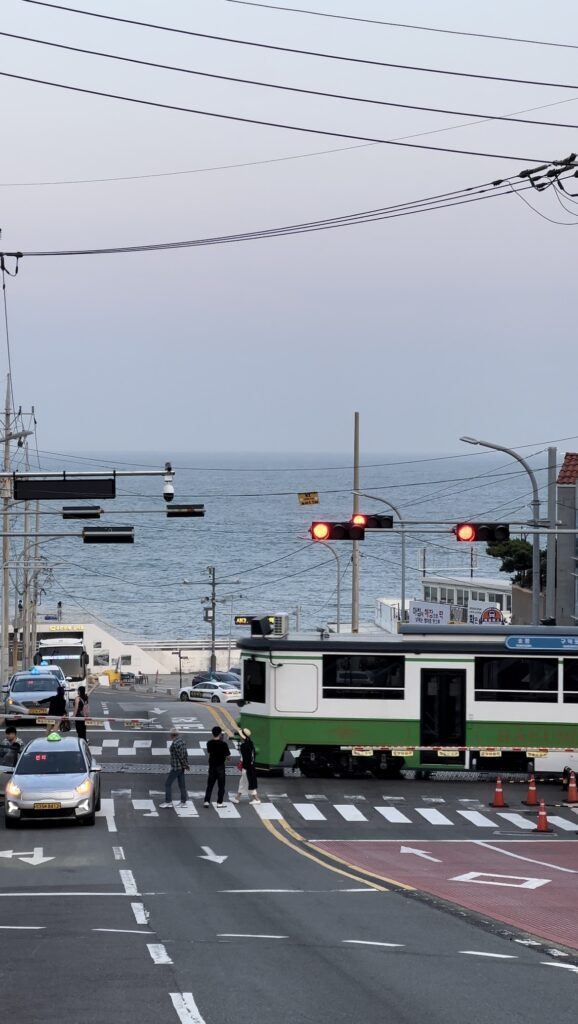
The Haeundae Beach Train is an iconic sightseeing train along the Busan coastline. The most iconic photo/video spot for this train is on Cheongsapo-ro road near the Cheongsapo station. Every 15 or so minutes, the sightseeing train crosses the road and stops at Cheongsapo station for passengers. This track, in particular, is famous because the background is the ocean and makes for a very picturesque scene.
You’ll often see photographers, influencers, and tourists crowding the sidewalk of the train station to witness the train passing. There are so many visitors that there is a security guard ushering people off the track and road before a train passes. You can also ride the scenic train for great views of the Busan coast.
8. Relax at Haeundae Beach
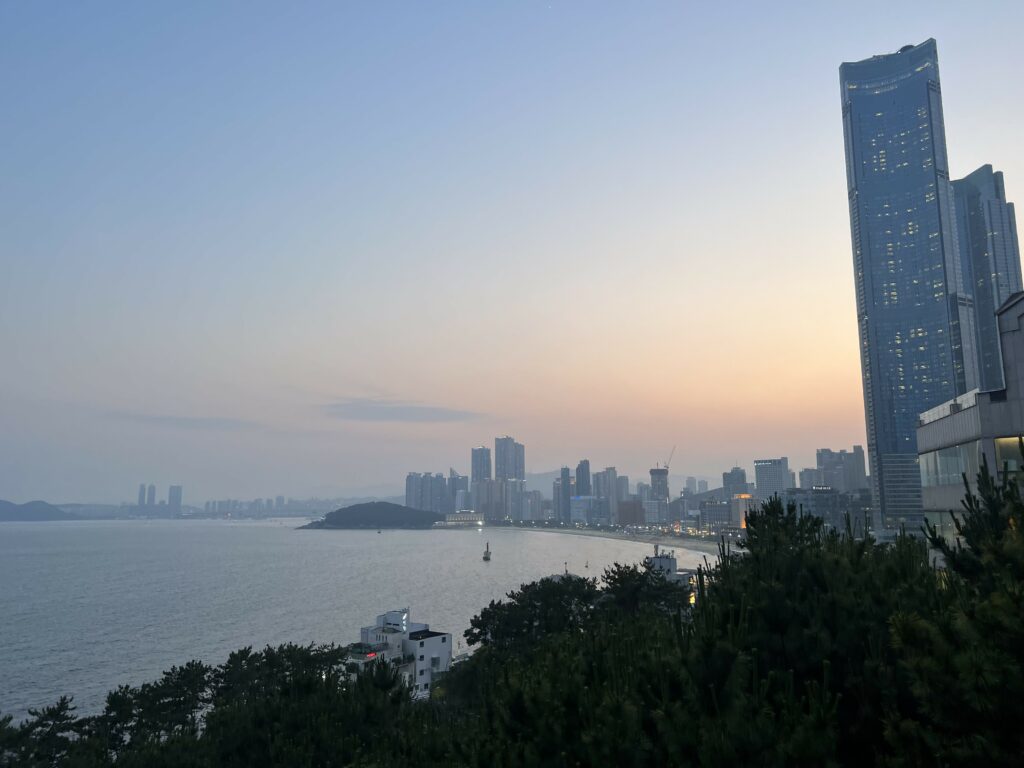

Haeundae Beach is famous all across Korea for its blue waters and white sand and is the most famous beach in Busan. You can walk along the beach to Dongbaekseom Island, which extends to the Dongbaek Coastal Trail and offers great views of the beach and city. Like Gwangalli, Haeundae Beach also comes alive at night, with tons of eateries, bars, clubs, and shops lining the beach and area.
There are also lots of events hosted at this beach, with the most famous being the Haeundae Sand Festival from May to June annually. Tons of artists come and make elaborate sand castles or sand art plucked right out of our imagination. The vibes are great for everyone, from couples to families, and there’s always something to see or do.
9. Visit the Haeundae Traditional Market
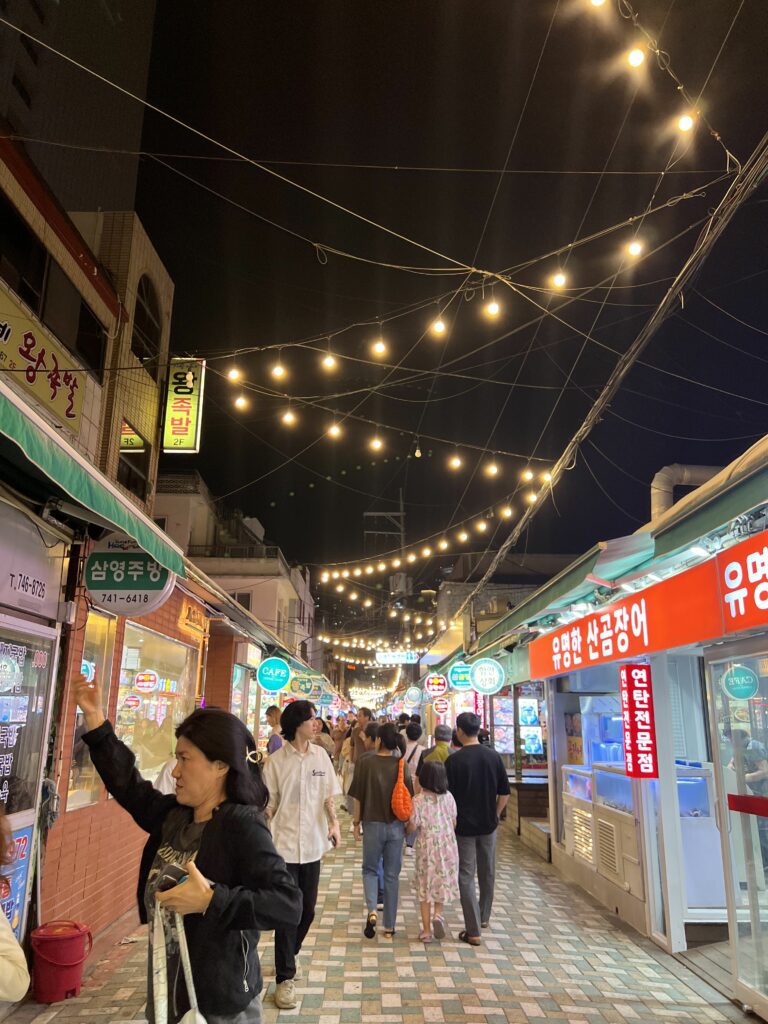

After walking around the beach, stop by the Haeundae Market for a quick snack or meal. Tucked away in this alleyway are stores selling homewares and fresh produce and food stalls selling fresh seafood and more. You can find everyday cooking and eating ware to take home, like soju shot glasses and long handle spoons. You can also try street food like tteokbokki or more adventurous foods like sannakji (raw octopus), all for good prices! There are multiple famous stalls in this alleyway, and locals and tourists alike line up for their delicious food. It’s also very accessible via public transport, giving you all the more reason to visit!
10. Walk Through Gamcheon Culture Village
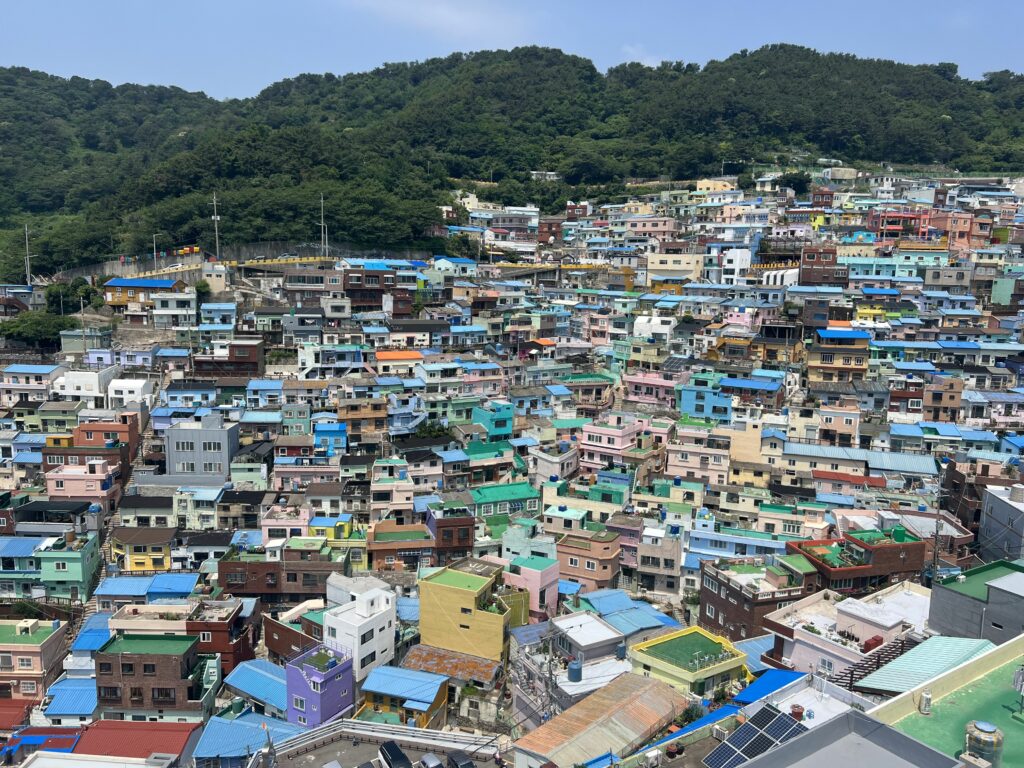
The Macchu Picchu of Korea. Arguably, the most famous destination for tourists is this small, colorful village tucked away in a staircase-like fashion in the mountains. The houses are all brightly colored, with great hues of blue, red, pink, and green. It started as makeshift housing for Korean War refugees and eventually was renovated by the government in 2009. The village partnered with local artists and residents who helped paint murals all across the town.
Everywhere you turn, you are met with color or a surprise art installation or mural. At the visitor center, you can grab a map and explore, following their walking guide. Or, you can get lost in the dizzying array of streets and see where it takes you.
Gamcheon Culture Village also has tons and tons of cafes that you can sit at and enjoy. Most of the cafes market themselves as having great views of the village, and it’s a great refuge on a hot day. Note that there aren’t really restaurants in the village, so be sure to eat something beforehand so you don’t explore on an empty stomach. This destination is accessible by public transportation—there are even buses that take you straight there because of its popularity. It’s definitely a site worth seeing, and the urban landscape and scenery blow you away.
11. Visit the Lego Village

The Gamcheon Culture Village’s less known sibling. Fun fact: Jungkook from BTS actually grew up near here in the Mandeok-dong neighborhood and went to Baekyang Middle School nearby! I first discovered this place from a tourist map I saw at Beomosa Temple, and after seeing pictures of it online, I was instantly hooked. There aren’t many single home houses in Korea, so this was something special.
Built in 1986, this neighborhood has 54 single-family homes arranged in a small grid in six rows of nine. Each home is the same shape, with windows and chimneys in the same places but different colored roofs. From afar, the homes resemble Lego houses situated right next to each other, earning it the nickname “Lego Village.”
Finding this incredible view was so easy feat. I actually walked down a mountain and around the neighborhood, puzzled by where I could find a bird’s eye view of the houses. There was no way someone was able to get a view of this village as there was a huge apartment building blocking the mountain behind it. I nearly stepped on the bus to go back when I found a Korean review of the same apartment building that I passed by on the street that said the view was from inside the building! So I tried my luck, and low and behold… I almost cried with happiness.
12. Shop Around Gukje Market
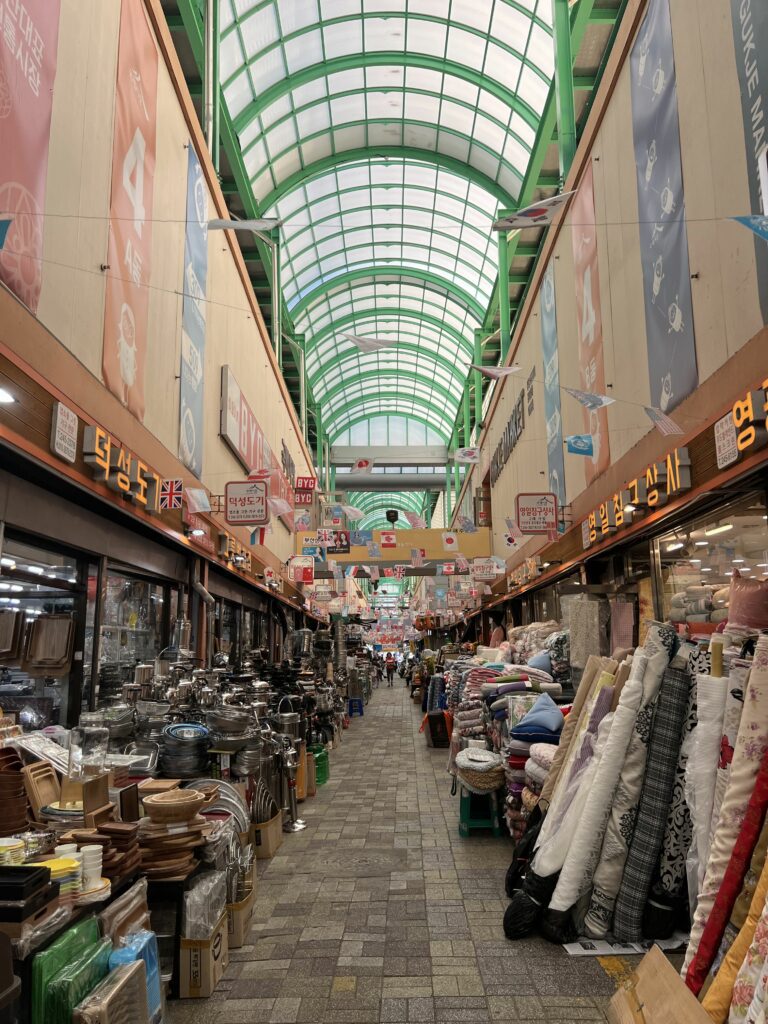

The famously loud and bustling Gukje Market, full of people, energy, and items, is the perfect place to get lost in. Like Bongsudong Book Street, Gukje Market was also started by Korean War refugees looking to make a living after the Korean War. A majority of the goods back then were U.S. Army supplies, electronic products, and imported foreign goods. To this day, the market’s alleyways are lined with stalls selling diverse goods, mostly machinery tools, kitchenware, and clothing.
This market, along with several other streets in the area, make up the main commercial district of Busan. To the market’s right is a charity shop alleyway filled with secondhand clothing and goods. On the left is Kkangtong (tin can) Market, which got its name from the numerous U.S. canned goods during the Korean War. To the north is Bosudong Book Street. Within the market is also Gukje Market Food Street, with food stalls with open seating lined up down the street. It’s famous for its Chungmu Gimbap, which is bite-sized plain rice rolled in seaweed and served with spicy radish and squid salad.
This is the perfect place to get household wares—you’ll find everything from aluminum teapots to large soup pots, pillows, rugs, glassware, clothing, shoes, and more. Anything you could ever need, you’ll find in a maze-like market. Small stalls are filled to the brim, often only leaving a small hole for the vendor to sit on a chair and lean their phones against something. Go for the vibes!
13. Try Seafood at Jagalchi Market


Jagalchi Market is Korea’s largest seafood market, and it is best known for selling fish. There are countless stalls inside and outside the market selling freshly caught fish, squid, sea squirt, octopus, etc. A fun fact is that most of the fish sellers at the market are women, so their nickname is Jagalchi Ajumma, ajumma meaning middle-aged woman. Like most seafood markets in South Korea, the appeal is that you can browse, pick, and buy fresh seafood and have it cooked for you. Just be prepared for vendors to greet you and aggressively point you toward their goods.
There are usually two levels of the market: the fresh seafood purchasing floor and the restaurant floor. Lots of seafood stall owners have deals with the restaurant owners as well. Once you buy your selected seafood, if you want to eat it there, they help you! I recommend coming here with a group of people or on a very empty stomach. Most vendors only sell a certain portion of seafood, usually for 2-4 people. Having the food prepared at the restaurants in the market also costs a fee on top of the seafood price. By going with multiple people, you can cut costs and get more value for your purchase!
14. Visit Beomosa Temple
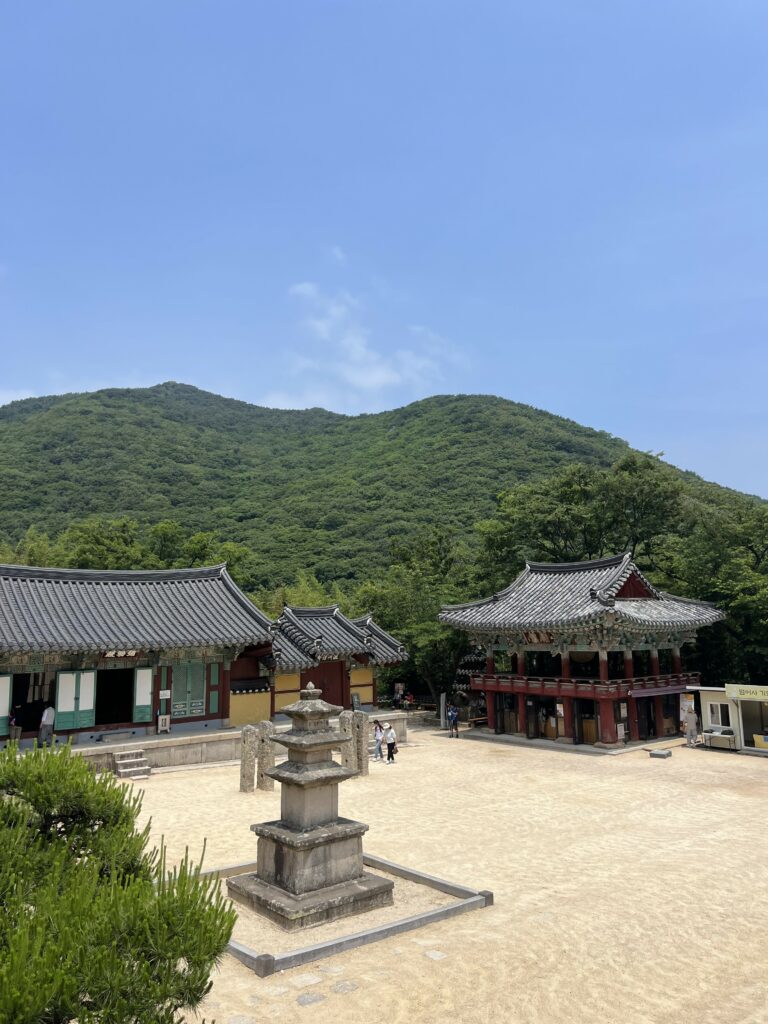

Beomosa Temple is a picturesque Buddhist temple built on the side of the famous Geumjeongsan Mountain. It was founded by a monk in 678! It’s a popular temple to meditate and pray at due to its serene location in the mountains. This temple also has a lot of preserved cultural property that is cool to see on the temple grounds.
You can walk around the temple and its halls, and you’ll often see monks walking around and hear prayer chants happening in a hall. This temple is incredibly serene, and I could not stop admiring the mountain in the background. It’s tucked into such a cozy location, and I really can’t imagine a more perfect spot for a temple. If you visit, make sure to be respectful of the prayers going on!
Another popular activity at Beomosa Temple is the temple stay program. It’s a relaxation-focused stay where you participate in meditation ceremonies as you stay overnight at the temple. I wish I could have done this when I visited Busan in May! I found out when I got to the temple. You can reserve a spot here. There is also a popular hiking course on the mountain that starts at the temple’s parking lot. Luckily, there is free bug spray before you enter the temple at the bottom of the steps before cars turn in.
15. Walk Around Hoedong Reservoir

Hoedong Reservoir is the largest reservoir in Busan and also has the most popular walking trails in the city. The reservoir is surrounded by a cypress forest that is absolutely stunning in the fall. Nature lovers flock here to enjoy the serene atmosphere and largely untouched nature around the water. At all seasons, the scenery is gorgeous, with hydrangea blossoming in the spring and green foliage in the summer. I walked the start of a trail before realizing that the walking trail is quite long (5 hours long) and immediately turned back, haha.
There are a bunch of cafes and restaurants leading up to the start of the trails, which I happily indulged in. Seonyudowon is an amazing bakery cafe serving delicious French-style pastries and their specialty peach milk tea with incredible views of the reservoir. Getting to the reservoir was a bit of a struggle, as the bus is a special route and only comes every HOUR, with less frequency on the weekends, so make sure you know when to get back to the bus stop!
16. Visit Haedong Yonggungsa Temple

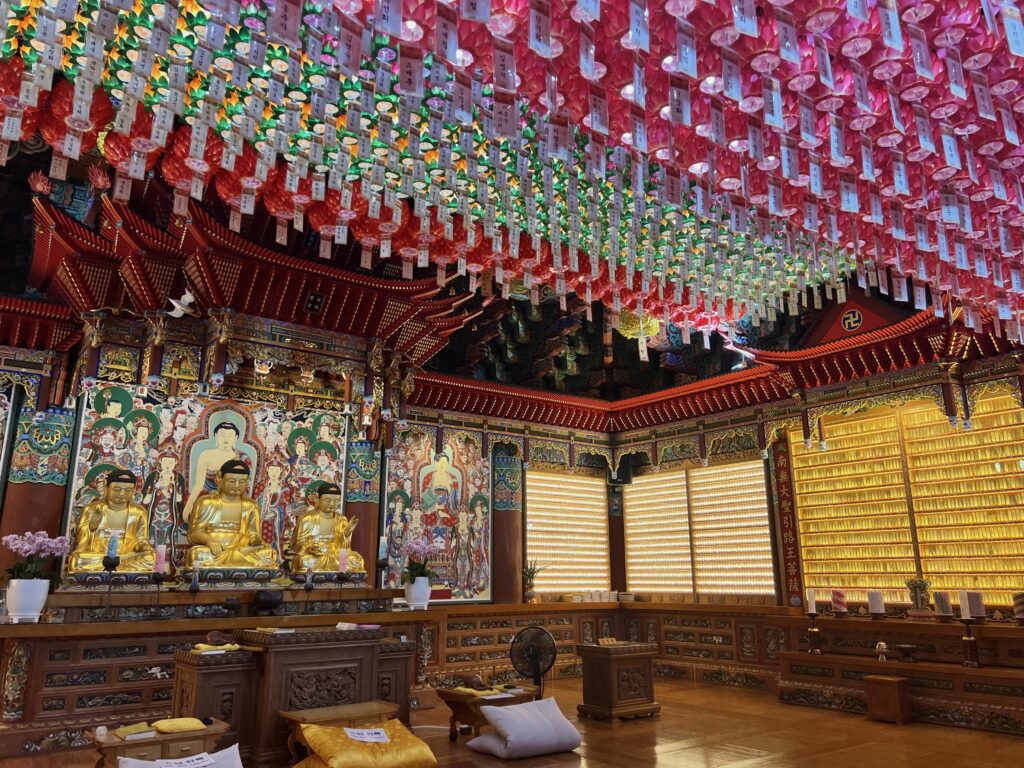
The most beautiful temple I’ve ever visited. Haedong Yonggungsa Temple sits on the seaside on Busan’s northeast peninsula. It was built in 1376 by a Buddhist teacher and was rebuilt in 1970 after a devastating fire in the 1500s. Walking to the temple, you’ll pass by a street lined with vendors selling refreshing drinks and street snacks like hotteok. Once you make it to the front gate, you immediately get transported to a different world. The temple path loops around at the start, so it’s easy to navigate around the grounds.
I hear it gets crazy busy during the day, but I visited about an hour before the temple closed and had it all to myself. You walk down a slope to the main grounds, where you get an incredible view of the ocean. There is also a bridge you can walk over and up stairs to get a side view of the entire temple nestled in the mountains with a seaside view.
The temple was covered in paper lanterns when I visited in May, and it was so picturesque! The prayer halls are the most beautiful ones I’ve ever seen in my LIFE! Definitely the best one I’ve ever prayed in. This temple is stunning and very tranquil; I highly recommend stopping here to take in the serenity. I would visit early morning or just before closing to avoid crowds.
Have a Great Time in Busan
Busan has so many places to see, things to do, and food to eat that no matter what you decide to do, you’re going to have a great time! The atmosphere is relaxed and laid back, and the city is incredibly well-connected by public transit. You can get to the beach and go to a temple in the mountains easily on the same day. No other big city offers such a diversity in scenery, which makes Busan incredibly special. Now, the hard part is choosing which things to do in Busan, South Korea, especially if you have limited time. But we always need a reason to return! Happy travels!
Relevant Reads
The Best Things to Do in Singapore for Easy Planning





